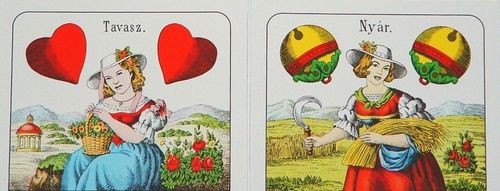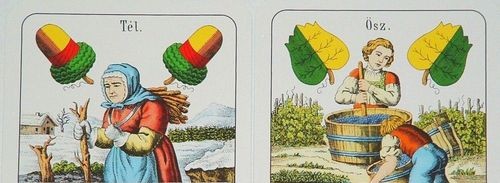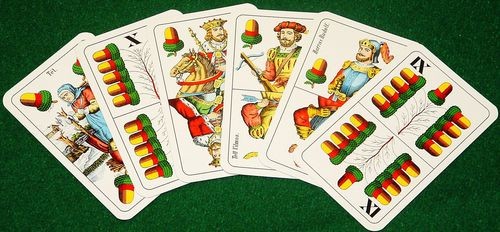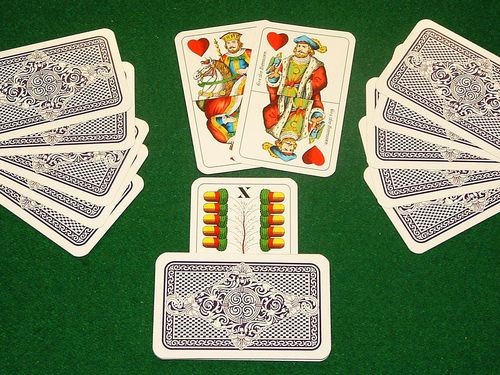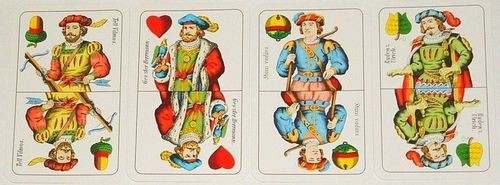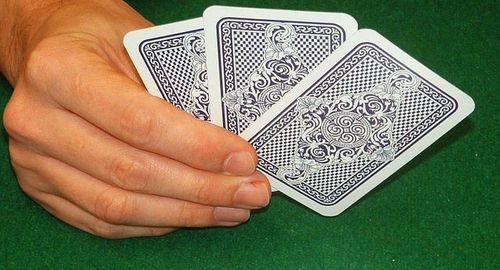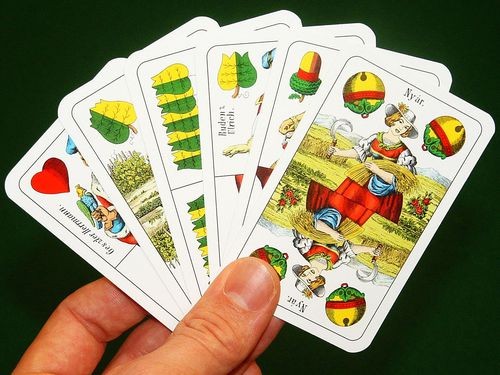Schnapsen: A Trick-Taking Classic for Two Players
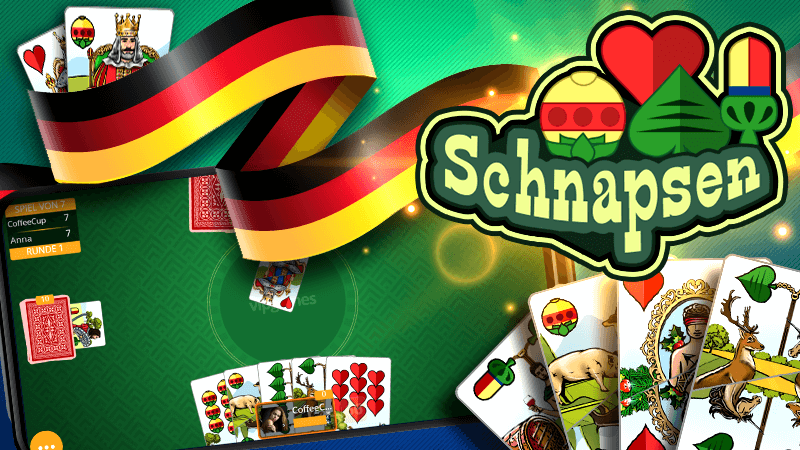
Table of Contents
In the world of games with playing cards, trick-taking games are one of the most popular genres. It’s a key mechanic in many classic card games played with a traditional deck, such as Whist, Bridge, Euchre, Hearts, and Spades.
There’s a good reason that trick-taking games are much-loved, because they typically allow a real degree of skill as part of the decision making.
Trick-Taking Games for 2 Players
But the problem is that most trick taking games cater exclusively to four players or more. What about when you just have two players? Fortunately there are some great trick taking games that handle just two players:
- German Whist – Probably the easiest of them is Germany Whist, sometimes also called Honeymoon Whist. It’s easy to learn, and is an excellent game in its own right. Each player has a hand of 13 cards.
The first phase involves each person playing a card in order to compete for the face-up card from the top of the stock (the very first card shown is the trump suit). The winner gets that card, while the loser gets the next face-down card.
When the stock is gone, you play out your remaining 13 cards, and the player getting the most tricks overall is the winner. - Briscola – Of Italian origin is the classic trick-taking game Briscola, which caters for 2-6 players. It’s also quite easy to learn and play, particularly as a two player game.You only use 40 cards, and the aim is play tricks from your hand of three in order to win point scoring cards. The somewhat unorthodox point value of the cards can take a bit to get used to, but even older children can manage this game without too much difficulty.
- Le Truc – Because I love bluffing games, perhaps my favourite trick-taking game for 2 players is Le Truc. This is a 19th century French game that was derived from the older and simpler English game Put, and was especially popularized after inclusion in Sid Sackson’s book Gamut of Games.It’s a brilliant bluffing game that uses a 32 card deck, and you use a hand of three cards to play only three tricks. The genius of the game is that you can increase the value of a hand as tricks are being played, in order to bluff and attempt to cause your opponent to fold.
- Schnapsen – But when it comes to a game of real skill it is hard to beat Schnapsen. This classic trick-taking game for 2 players is the national card game of Austria.It has a long history, and continues to be popular in many parts of Europe today. Best of all, it allows for genuinely skillful and clever play. Played with a small deck, one of its peculiarities is how points are scored for “marriages” (King-Queen couples). It is closely related to another game called Sixty Six, and the two games are very similar.
In this article I’ll teach you some of the basics about Schnapsen, and also introduce you to its brother Snapszer, which is a four player version of the game popular in countries like Hungary. If you know Schnapsen, in fact you’re already 90% of the way to learning Snapszer!
The Schnapsen Deck
Unlike some card games, to play Schnapsen you don’t need a complete deck of 52 cards. In order to play, you only need 24 cards, namely the 9s through Aces in all four suits from a regular deck of playing cards.
Many decks in Europe consist of only 32 cards or 40 cards, so games with less cards are very common in this part of the world. A smaller deck can also make games tighter and the gameplay tenser. Every play matters, and that’s certainly true with Schnapsen.
I’ve already mentioned that Schnapsen and Sixty Six are practically identical games under different names (for a comprehensive overview of the differences, see Martin Tompa’s excellent resource pages here and here).
Strictly speaking there is a small difference between them, namely this: Sixty Six uses the 9s through Aces, while Schnapsen uses the 10s through Aces and omits the 9s. Because the 9s are not worth points, this makes the game somewhat tighter, because every single card played is worth points.
The gameplay is virtually the same for both games, except that in the game with the even smaller 20 card deck you get a hand of five instead of six cards. I’ll technically be describing the Sixty Six rules, but like many others I’ll just call it Schnapsen since that’s the most common designation, and for this article we won’t worry about the names.
If you want to add some more character to your game, you can play Schnapsen with a special Tell deck like the ones that are still popular in parts of Germany and the region of former Austria-Hungary.
These are produced by playing card manufacturer Piatnik, and have artwork that is more typical of decks from that part of the world. Instead of the traditional French suits, these use Acorns, Hearts, Bells, and Leaves.
In some of these decks, the art depicts various characters and aspects of the famous story of William Tell – hence the name of the deck. But you certainly don’t need a Tell deck to play Schnapsen, and can play it with a traditional deck of playing cards.
In a Tell deck the cards have different names, with the Queens and Jacks being called Over-Knaves and Under-Knaves, so this can take some getting used to. If you are lucky enough to own a Tell deck, it can enhance your playing experience, as well as give you lovely artwork to admire while you’re playing.
The pictures accompanying this article feature cards from a Tell deck, to add to the visual appeal. But for most of us, it makes sense to play with a deck that we’re already familiar with, and thus to use standard playing cards.
Schnapsen Points
The aim of Schnapsen is to be the first player to reach 66 points. You earn points by winning tricks that contain cards worth points, and you can also score bonus points for “marriages“, which we’ll get to in a moment.
Card values:
The first thing we need to learn is the ranks and point values of the cards in our deck. These are different from most other trick taking games, and are as follows:
- 11 points – Aces
- 10 points – 10s
- 4 points – Kings
- 3 points – Queens
- 2 points – Jacks
- 0 points – 9s
Especially note the special honour given to the Ace, which is considered to be the highest-ranked card in a game of Schnapsen, beating the court cards (Kings, Queens, and Jacks).
Marriages
Aside from earning points by collecting point cards gathered by winning tricks, the second way to earn points is by achieving “marriages“. As you might expect, a marriage consists of a King and a Queen pair in the same suit. This is worth 20 points, while a marriage pair in the trump suit is worth 40 points.
A marriage is declared by revealing this pair from your hand at the moment you lead a trick, and then playing one of these two cards.
Schnapsen Game-Play
At the start of a game, each player is dealt six cards, after which the starting player turns the next card face-up to determine what suit is the trump. The 11 cards that remain are placed face-down on this face-up card, and these serve as the draw pile for the rest of the game.
Before closing the deck
Playing tricks
The non-dealer starts the game by leading a trick. As is typical of most trick-taking games, the higher valued card of a suit wins the trick, and this can be beaten by a card played from the trump suit. But one interesting element about the game-play in Schnapsen is that you are not obliged to follow suit.
Naturally this introduces a range of completely new decisions that are usually not available to you. Besides this departure from standard trick-taking, the game proceeds in the same manner as a normal game, and the winner of a trick leads to the next trick.
Both players draw a card after each trick, in order to replenish their hand.
Declaring marriages
So where do the marriages come in, and how do you gain bonus points from these? You can declare a marriage whenever you lead a trick. For example, if I’m leading and have the King and Queen of Hearts in hand, I could show those two cards and then play either of them, to score 20 bonus points.
If Hearts happened to be the trump suit, this play would be worth 40 points. The goal, remember, is to be the first to get to 66 points, so the points scored from declaring marriages can be very lucrative, because they are scored in addition to those earned by winning tricks. A big part of the strategy involves trying to keep the necessary cards in hand which might allow you to draw the card you need to get such a “marriage”.
After closing the deck
Another fascinating element of Schnapsen happens after the deck is considered “closed”. This occurs when the winner of a trick turn the face-up trump face-down, which they can do at any time after winning a trick. This closes the deck, and it means that from now on you can no longer take cards from the draw pile, and instead you must simply play out the cards you have in hand.
Now the rules of play change, because players must follow suit, and the rules of regular trick taking apply.
In fact, the requirement is even more strict than a standard trick-taking game, because you must beat the card that was led with a card of the same suit if you can. And you must trump the card led if you do not have a card of the same suit, but do have a trump.
Marriages may also not be declared after the deck has been closed, and now it becomes a race to be the first to get to the game-winning target of 66 points. In fact, whenever you win a trick that brings you to magical 66 points, you can announce that, and the game stops.
It’s up to you to keep careful track of your points in your mind as you go along, so it is important to be certain that you actually have the necessary 66 points before claiming your win!
You can even claim an instant win if the deck hasn’t been “closed” yet, when declaring a marriage nets you the 20 or 40 points needed to get you over the 66 points needed to win.
Snapszer for 4 Players
So what if we have four players? That’s where Snapszer (also called Snapszli) comes in. It’s extremely popular in Hungary, and is effectively a partnership variant of Schnapsen. It’s an excellent game in its own right, and is very easy to learn if you already know how to play Schnapsen.
A 24 card deck is used just like with Schnapsen, but the lead player gets to look at the first three of his six cards, and call another card – that card determines the trump suit. The player that holds that card is his partner, or he must play alone against the other three players if this card happens to be one of his remaining three cards.
Game-play goes in an anti-clockwise direction, but the game-play requirement that you must follow suit and beat the led card if possible (which only applies to the last phase of the game in Schnapsen) applies to the entire game in Snapszer, and there is also no draw deck.
Just like Schnapsen, the aim is to be the first to reach 66 points, but as a partnership. Until the called trump card is actually played, players are scoring individually, and the partnership is only formed when that card is played.
Marriages work in the same way, by declaring a King and Queen pair in the same suit when leading a trick, but you need to win at least one trick in the round otherwise these points are forfeited.
The starting player can say “Snapszer” before leading the very first trick, which means that he aims to get to 66 points without the opponents winning any tricks, earning a massive 6 points overall.
His called partner can also initiate a Snapszer by calling this when playing the called trump card as his first card. But calling Snapszer is risky, because you fail if your opponents win any tricks at all.
The opponents can also ramp up the value of a round by proposing to double the score of that round, which happens by announcing “Kontra” before the first card of that round is played. The starting player can even double that again by saying “Rekontra” after the first trick, and the opponents can double it further by saying “Subkontra”. So before you know it, the stakes can be very high!
The interesting thing about Snapszer is that partnerships change every round. Both players in a winning partnership get the amount of points earned for the win, but scoring is individual due to the changing partnerships.
Schnapsen Impressions
Schnapsen is a fascinating game, and the game-play revolves a great deal around timing the best moment to close the deck. Do I think I have the right cards and can I guarantee myself the points I need to win?
The fact that the rules of play change when the deck is closed makes this especially interesting. There’s a relatively small pool of cards in the game, and being able to keep track of what has been played is essential, leaving a lot of room for skill.
You also need to keep careful track of your points as you go along, so there’s a great deal to think about as you play. The decisions are interesting and often difficult, and if you enjoy some real mind-crunching, you will absolutely love this!
Schnapsen has to be considered as one of the best trick taking games for two players that I’ve ever tried. Games don’t take long, and yet the choices are deep and crunchy. Whatever luck of the draw is present quickly evens out over several hands.
The changing rules that are initiated by closing the deck generate new considerations that make the game particularly fascinating. Ideally it is important to set yourself up with the right cards for this latter phase, as well as to get points from marriages in the first part of the game.
The partnership version of the game for four players, Snapszer, is also excellent. While it lacks the interesting turning point where the rules of play change, it introduces a fascinating new aspect by having a named trump card determine a secret partner.
Until the called card is actually played, the identity of this partner remains secret, and this creates a nice element of surprise and fun, because you will be trying to figure out who the partner is, basing your suspicions on the decisions that are made by the players in game play.
Given how much fun the partnership game is, if you have taken the trouble to learn Schnapsen, you owe it to yourself to give the four player Snapszer a shot as well.
Recommendation
You will find plenty of resources on the internet to help you begin your journey in discovering the fun that Schnapsen can offer. The rules can be found readily online (e.g. Pagat and Wikipedia). I have found som errors in some explanations of the game in published books, so be aware of the possibility of omissions and mistakes. Martin Tompa’s site can especially be recommended as a reliable resource about the game. What’s more on it you can also find a useful app written by his friends- J. Scofield and D. Garner. You can try the free Schnapsen app here which can also be played in the browser if you prefer.
Unfortunately the rules of Snapszer are not readily available in English. A Hungarian couple first taught me how to play this form of the game, and some private email correspondence with gamers in Hungary also assisted me in clarifying some of the finer points of game-play, which I’ve described above.
Schnapsen is an outstanding two-player game, and if you enjoy trick-taking games, you really should give it a try. It’s a wonderful alternative to other classic card games, and those who are familiar with it often consider it to be the best two-player trick-taking game that there is, in view of the tension around the closing of the stock, the unusual card-play, and the skilful choices it requires.
If you are looking for a good two player game with a traditional deck, it’s certainly one of the absolute best games there is!
Also you can try a classic board game for 2 players too.
About the writer: EndersGame is a well-known and respected reviewer of board games and playing cards. He loves card games and everything related to playing cards. He has reviewed several hundred board games and hundreds of different decks of playing cards. You can see a complete list of his game reviews “here, and his playing card reviews here. He is considered an authority on games and on playing cards and has many contacts within the game and playing card industries.
Subscribe now
Receive updates and latest news about VIP Games. Simply enter your email below and get notified!
You will only receive quality content.
Signing up for newsletters indicates you agree with our Privacy Policy. If you decide that you no longer want to receive a newsletter, you can unsubscribe by clicking the “Unsubscribe” link, located at the bottom of each newsletter.

